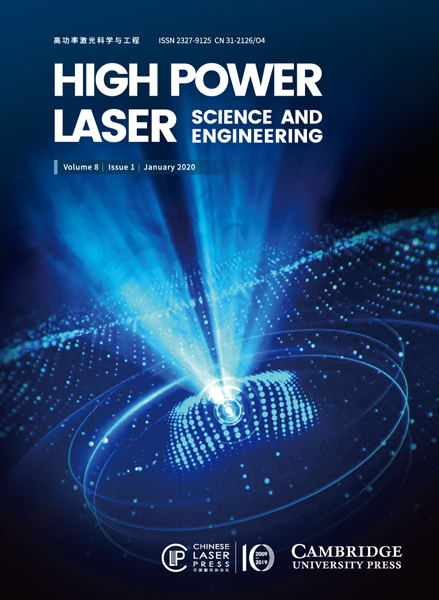2015, 3(2) Column
High Power Laser Science and Engineering 第3卷 第2期
A fully coherent free electron laser (FEL) seeded with a higher-order harmonic (HH) pulse from high-order harmonic generation (HHG) is successfully operated for a sufficiently prolonged time in pilot user experiments by using a timing drift feedback. For HHG-seeded FELs, the seeding laser pulses have to be synchronized with electron bunches. Despite seeded FELs being non-chaotic light sources in principle, external laser-seeded FELs are often unstable in practice because of a timing jitter and a drift between the seeding laser pulses and the accelerated electron bunches. Accordingly, we constructed a relative arrival-timing monitor based on non-invasive electro-optic sampling (EOS). The EOS monitor made uninterrupted shot-to-shot monitoring possible even during the seeded FEL operation. The EOS system was then used for arrival-timing feedback with an adjustability of 100 fs for continual operation of the HHG-seeded FEL. Using the EOS-based beam drift controlling system, the HHG-seeded FEL was operated over half a day with an effective hit rate of 20%–30%. The output pulse energy was 20 mJ at the 61.2 nm wavelength. Towards seeded FELs in the water window region, we investigated our upgrade plan to seed high-power FELs with HH photon energy of 30–100 eV and lase at shorter wavelengths of up to 2 nm through high-gain harmonic generation (HGHG) at the energy-upgraded SPring-8 Compact SASE Source (SCSS) accelerator. We studied a benefit as well as the feasibility of the next HHG-seeded FEL machine with single-stage HGHG with tunability of a lasing wavelength.
arrival-timing monitor arrival-timing monitor electro-optic sampling (EOS) electro-optic sampling (EOS) high-gain harmonic generation (HGHG) high-gain harmonic generation (HGHG) high-order harmonic generation (HHG) high-order harmonic generation (HHG) self-amplified spontaneous emission (SASE) self-amplified spontaneous emission (SASE) the soft x-ray water window region the soft x-ray water window region wavelength-tunable seeded FEL wavelength-tunable seeded FEL X-ray free electron laser (XFEL) X-ray free electron laser (XFEL) With the development of ultraintense terawatt (TW) and petawatt (PW) laser systems, powerful terahertz (THz) radiation from laser–plasma interactions has been reported. Plasma-based THz systems, which are usually operated at extremely low repetition rates, call for single-shot diagnostics. In this paper, various state-of-the-art single-shot detection methods are introduced or designed for measurements and applications involved in high-power plasma-based THz sciences.
laser–plasma interaction laser–plasma interaction single-shot detection single-shot detection terahertz radiation terahertz radiation To establish the mechanism of surface change in a continuous polishing system, an ideal mathematical model is built based on Winkler’s hypothesis and the Preston equation. The basic features of the model are the change rates in the surface peak–valley (PV) values of the workpiece, conditioning disk and pitch lap, rather than the specific surface shapes. In addition, an equilibrium state exists in the system, indicating that the surface change rates are all zero. Under equilibrium, the surface of the lap could remain flat, and it is insensitive to the surface error of the workpiece. These characteristics lay the theoretical foundations for high-efficiency and high-precision polishing. The methods to obtain an equilibrium state with flat surfaces are then proposed and confirmed experimentally. High-precision surfaces better than λ/10 (λ=632.8 nm) are consistently produced experimentally.
continuous polishing continuous polishing equilibrium state equilibrium state high accuracy high accuracy high efficiency high efficiency surface figure control surface figure control Hydrodynamic instability experiments with three-dimensional modulations at the National Ignition Facility Download:813次
Download:813次
 Download:813次
Download:813次The first hydrodynamic instability growth measurements with three-dimensional (3D) surface-roughness modulations were performed on CH shell spherical implosions at the National Ignition Facility (NIF) [G. H. Miller, E. I. Moses, and C. R. Wuest, Opt. Eng. 43, 2841 (2004)]. The initial capsule outer-surface amplitudes were increased approximately four times, compared with the standard specifications, to increase the signal-to-noise ratio, helping to qualify a technique for measuring small 3D modulations. The instability growth measurements were performed using x-ray through-foil radiography based on time-resolved pinhole imaging. Averaging over 15 similar images significantly increased the signal-to-noise ratio, making possible a comparison with 3D simulations. At a convergence ratio of _2:4, the measured modulation levels were _3 times larger than those simulated based on the growth of the known imposed initial surface modulations. Several hypotheses are discussed, including increased instability growth due to modulations of the oxygen content in the bulk of the capsule. Future experiments will be focused on measurements with standard 3D ‘nativeroughness’ capsules as well as with deliberately imposed oxygen modulations.
Hydrodynamic instabilities Hydrodynamic instabilities 动态信息
动态信息 丨 2023-06-21
HPL Highlight (Vol. 11, e40): NIF仍然是全球唯一一个能够进行ICF点火实验的装置动态信息 丨 2023-06-21
HPL Highlight (Vol. 11, e9): 变分神经网络预测激光尾波场加速电子能谱动态信息 丨 2023-06-21
HPL Highlight (Vol. 11, e7): 目标探测网络加入,激光等离子体加速器实现实时诊断动态信息 丨 2023-06-21
HPL Highlight (Vol. 11, e5): 910 nm波段超宽带种子源,向100 PW超强超短激光进发动态信息 丨 2023-06-21
HPL Highlight (Vol. 11, e4): 100 PW单束压缩!多步压缩器进阶双光栅激光评论微信公众号

点击菜单“联系编辑”即可添加期刊编辑为好友啦




